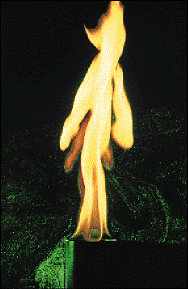Kathleen G. Tatterson
WEST LAFAYETTE, Ind. -- The old adage "Where there's smoke, there's fire" could give way to "Where there's flickering infrared radiation, there's fire," if researchers at Purdue University have their way. They have developed a fire detection device that senses flames by measuring the near-infrared light in a single room or throughout a floor of a building.

Purdue researchers analyzed the radiation of fires fueled by several types of materials for their optical NIR fire detection sensor.
|
Light travels faster than smoke; therefore, a system that detects light from farther away provides an earlier warning, said Jay Gore, professor of mechanical engineering at Purdue. Unlike smoke detectors, this system can sense the heat that "bounces" off walls, so it doesn't have to aim directly at the source. "It can amplify the signal as much as 1 million times," he said.
Also, the incidence of false alarm is lower because such a system would not go off if someone burns the toast; therefore, people would be less likely to turn off the detector altogether.
Optically detecting fire is not a new idea, but the infrared-based detector responds to lower temperatures and high-combustion products, as opposed to sensors that depend on UV radiation. "If you have a hidden flame with hot gases radiating, the IR detector will pick it up," Gore said. Surrounding materials, such as a painted wall or window glass could absorb UV radiation at such levels, making it difficult to detect.
Fewer false alarms
Gore and colleague Yudaya Sivathanu built the two-channel detector, which picks up two NIR wavelengths -- one at 900 nm to measure the heat intensity and the other at 1000 nm to compare the heat with the discrimination algorithm in the system's digital signal processing chip, eliminating false alarms. For instance, the system would not respond to the heat generated from a hot plate, because they have "taught" the system not to respond to that level of radiation.
Detector information would run from optical fibers to a central control unit -- ideally a computer -- which would flash a visual signal and sound an alarm. Gore envisions adding the capability to program a familiar voice to calmly deliver safety instructions.
However, the team needs to solve the problem of the alarm going off in the presence of seemingly uncontrolled heat sources, such as a fireplace. Also, the sensor will not detect a smoldering fire because it does not generate much heat.
The National Institute of Standards and Technology's Building and Fire Research Laboratory is supporting Purdue's work on the detector, which Gore said will be on the lookout for flames in homes within the next five years. En'Urga Inc., Sivathanu's Purdue incubator business, will market the device after scientists work out the bugs.
"The technology is available [to solve the problems], but we have not yet done the characterization necessary," Gore said.
